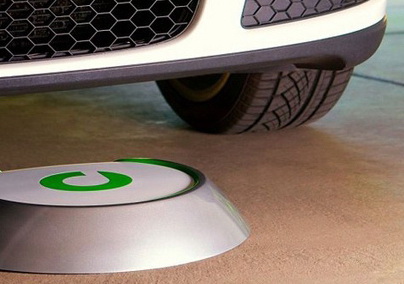The principle of electromagnetic induction charging is like a balance transformer. Each wire carrying current generates a magnetic field, and the magnetic field itself can generate electricity. If the directions of the magnetic fields of the two wires are the same, the energy can be wirelessly transmitted. Currently, it has been applied to electric toothbrushes and Smartphone chargers, induction furnaces, etc. The industry and the scientific community have cooperated for many years in the research of inductive charging of electric vehicles. The current practice is to install an induction coil at the bottom of the vehicle body and bury the charging device underground. However, as the distance from the ground reaches 15 centimeters, the power and volume of the coil are required to be large, which will increase the cost. In addition, animals or other objects may interfere with the transmission of electricity, such as cats are attracted to the floor when the heat is hot, more dangerous is the chewing gum, cigarette packaging paper and other metal-containing paper, under the car or by the wind to the car The inductively charged surface immediately warms up to spontaneous combustion. To this end, Fraunhofer’s experts have developed a pre-charging device that mounts the induction source on a charging pile. When the vehicle enters the vehicle, it can touch the induction source slightly, so that the required coil diameter is 80 cm. Significantly reduced to 10 cm. The system is more energy efficient, lower cost, and the charging process is less affected by other factors. The charging pile made of plastic is about waist high and will automatically move backwards when it comes in contact with the body. If the contact force is too great, it will fold down and fall back to the ground. The body will not be damaged, and the car can almost pass through. If the vehicle fails to accurately stop at the position where the center axis is facing the charging pile, power transmission can also be realized between the longitudinally overlapping induction coil in the pile and the laterally laminated coil at the rear of the license plate, and is not affected by the volume and height of the vehicle. IISB experts have been working on electric vehicles for 12 years and began researching inductive charging two years ago. During this period, the team of experts established a comprehensive knowledge system covering power electronics, electromagnetic field simulation, electromagnetic induction current distribution and other fields. The design of the coil is very important and determines the direction and strength of the magnetic field. In order to minimize the AC resistance, they designed a coil assembly consisting of a plurality of small coils that are thin and insulated from one another. At present, they have developed a prototype with a transmission capacity of 3 kilowatts and an energy efficiency of 95%. Existing electric car models can be fully charged at night. Their next research goal is to continue to increase the charging power to match the development of battery technology and the second is to continue to reduce the cost of charging stations. Current charging piles and electric vehicles are sold in bundles. Only when the cost is reduced to a suitable level, this charging technology can Become a mass product. Plate And Shell Heat Exchanger The plate and shell heat exchanger range of heat exchangers are new generation heat exchangers, combining the best properties of the Plate & Frame and Shell & Tube heat exchangers. The plate and shell heat exchanger provides high heat transfer rates with a high pressure and temperature operating range. They have no gaskets, are compact, low fouling and can operate at close approach temperatures.The application is Hydrocarbon condensers and evaporators;Heat-recovery exchangers like feed/effluent exchangers;Overhead condensers and gas liquefiers. Plate And Shell Heat Exchanger,Full Welded Plate Heat Exchanger,Shell And Tube Heat Exchanger,Plate And Shell Heat Exchanger Condenser Jiangsu Baode Heat-Exchanger Equipment Co.,LTD , https://www.baodehex.com
At the heart of the plate and shell heat exchanger is a fully welded pack of circular plates without gaskets. This plate pack is housed within a tubular shell to provide a strong compact construction. The plate and shell heat exchanger series have a very wide operating range with capacities of up to 100 MW / units, and can operate at pressures up to 100 bar and temperatures up to 400°C. They have a low maintenance design that provides flexibility to select different material and nozzle combinations.
Electrical wires are gradually fading out of people's daily lives. Cordless phones, wireless mice, and wireless headphones are not uncommon. Wireless charging electric toothbrushes and smart phones are becoming the new darling. Information can be transmitted over the air, and electrical energy can also be transmitted via electromagnetic induction. In recent years, electric vehicle experts are studying wireless charging devices for electric vehicles. Traditional contact charging has the risk of electric shock when it encounters weather conditions such as rain, snow, mud, or road conditions. In contrast, non-contact charging is more comfortable and safe. Experts at the Fraunhofer Institute for Integrated Systems and Devices (IISB) consider electromagnetic induction charging as one of the directions for future charging devices.